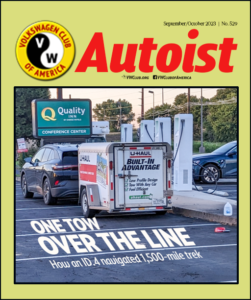 VW SUV 1, Skeptics 0
VW SUV 1, Skeptics 0
ID.4 hauls a load halfway across the country
By Todd Allcock
My youngest child started college shortly before this issue was published, so this summer I had the dilemma many parents face: how to get their child and several cubic yards of their child’s crap to a dorm or apartment, hundreds, or even thousands, of miles from home.
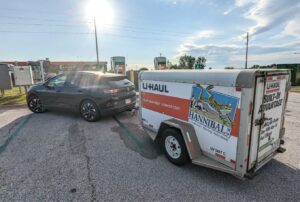
Despite being an EV enthusiast, and no longer owning any gas-powered cars, I’m not immune to the arguments of EV skeptics. Sure, I know long distance travel is possible in an EV, having done several 1,000-plus-mile trips myself in multiple EVs, but it’s “common knowledge” that EV range is destroyed by roof storage boxes or by towing trailers. This thought is so pervasive that I didn’t hesitate for a second, reserving a rental gas-powered van and buying a rooftop cargo bag to prepare for a 1,500-mile drive from Denver to Cincinnati.
As the travel date approached, I kept asking myself how much range would a trailer actually take from my AWD ID.4? Surely, someone has done it and reported their findings on the interwebs, right? A one-way trailer rental would be less than $400 vs. the $1,000 a van was going to cost and hold three times the cargo. Plus, with my ID.4, “fuel” is free thanks to the three years of Electrify America’s promo included with all new ID.4s. That sounded much better than the few hundred bucks it would cost to gas a van for 1,500 miles.
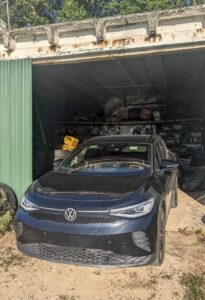
 The very few ID.4 towing anecdotes I could find in blogs and online videos were discouraging and had used teardrop campers rather than utility trailers. An RV blogger who pulled his teardrop trailer, and a YouTuber who pulled a similar trailer up a mountain in Colorado both got an efficiency of about 1.7 miles/kWh on flat terrain at 65 mph, or about a 45% range loss, so I used that number as an estimate and plugged it into the A Better Route Planner app. (“ABRP” is an excellent EV-specific route planning website and app, taking speed, temperature and elevation into account, and it calculates everywhere you’ll need to stop and charge along the route.)
The very few ID.4 towing anecdotes I could find in blogs and online videos were discouraging and had used teardrop campers rather than utility trailers. An RV blogger who pulled his teardrop trailer, and a YouTuber who pulled a similar trailer up a mountain in Colorado both got an efficiency of about 1.7 miles/kWh on flat terrain at 65 mph, or about a 45% range loss, so I used that number as an estimate and plugged it into the A Better Route Planner app. (“ABRP” is an excellent EV-specific route planning website and app, taking speed, temperature and elevation into account, and it calculates everywhere you’ll need to stop and charge along the route.)
If I could match that 1.7 miles/kWh efficiency others claimed to get, the trip would be possible. Anything less than 1.5, I’d be up the proverbial creek, as a few stretches in Indiana or Illinois would be impossible without the need to stop at slow overnight chargers, greatly extending the length of the trip, and more importantly, proving the skeptics right!
So, as the day approached, I hedged my bets and kept the reservation for the rental van. Then I picked up U-Haul’s smallest cargo trailer, a 4-by-8-footer, a day early to do some quick range testing on the highway before loading it up and starting the trip in case I needed to abort the mission and rent the van. I chose the 4-by-8 because it was barely taller than the ID.4, and I hoped to minimize wind resistance for better efficiency.
Trailer attached, I headed for the nearest highway on-ramp, reset the car’s trip computer and drove a 20-mile round trip at 65 mph to get an idea of what I was in for. To my delight, the car managed 2.8 miles/kWh with the empty trailer bouncing behind me. I left my route planning app set to a worse-case-scenario 1.7 miles/kWh, but I was now so confident the trip was doable, I canceled the van reservation and returned the unused roof bag.
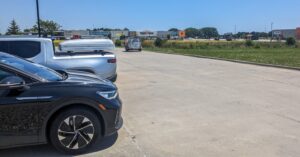
We packed the U-Haul to the brim with all of my child’s “essential items” (translation: 10 times as much stuff than needed!) and headed out the next day at 9 a.m. toward our overnight stop, Sioux City, Iowa, to visit my brother-in-law at his farm. (Not exactly on the way between Denver and Cincinnati, but a worthy diversion to see family!)
While we didn’t get the 2.8 miles/kWh I achieved with the empty trailer, we beat the 1.7 estimate handily, averaging 2.3 miles/kWh driving 65 mph, for roughly a 30% range loss from the usual 3.3 to 3.4 we’d get without the trailer at that speed. We did have the advantage of an elevation drop — losing nearly 5,000 feet, which helped with efficiency. (We averaged slightly lower on the flat roads for rest of the trip between Sioux City and Cincinnati, getting 2.2 miles/kWh, or a one-third range loss.)
Of course, just because a trip is possible, doesn’t automatically mean it will be pleasant. As discussed in the May/June Autoist, a road trip in the ID.4 takes me about 25-30% longer than the same trip in a gas car to allow for charging. The range loss from the trailer made it much worse because we needed to charge to a higher level than usual to make it to the next charger, and EV charging speeds slow the closer to full the battery gets. It generally takes 30 minutes or less to charge the ID.4, to 80% at a DC fast charger, but charging to the 90%, 95% or even the 100% that was sometimes necessary to get to the next charger with the trailer made many stops 45 to 55 minutes rather than 30 or less.
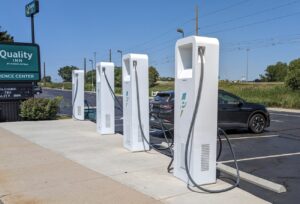
In addition, the trailer made charging far more complicated. Most chargers are designed to be pulled up to or backed into. With the trailer, power cords wouldn’t reach if we backed in, or the trailer stuck out too far if we pulled in. We were able to get creative a few times, pulling along side the last charger on the end of a bank of chargers, or twisting in at a tight angle with the trailer hanging out into the next (non-charging) spot. One time we even pulled in perpendicularly behind a bank of chargers and pulled the cord behind the charger to our car. But more often than not, we had to drop the trailer, charge and reconnect, adding another 10 minutes or so to many of our stops. (Though I eventually got much faster doing that after so much practice!)
The entire trip took about 26 hours of driving plus 10 hours of charging over three days. Comparatively, on the way back to Denver without the trailer, it took us a little over 24 hours of driving (without the trailer, we were able to drive at 75 to 80 mph instead of 65!) and spend 51/2 hours of charging. Google Maps predicts it would take more than 21 hours in a gas car, but I find those predictions are very optimistic, not accounting for fill-ups or restroom breaks, so I suspect it’d be more like 22-23 hours, especially with the slower speeds involved pulling a trailer. Assuming 23 hours, that means the 36 hours I drove and charged with the trailer took 57% longer than if I used a gas car, and the 291/2 total hours back without the trailer took 28% longer.
As expected, we incurred a huge time penalty using an EV to pull a trailer, but with the free Electrify America charging, the entire trip cost us about $20 in fuel, (we needed to use three non-Electrify America chargers on the trip.)
All in all, the journey went a little worse than I hoped, but much better than I feared. I’d probably do it again rather than rent a gas car for environmental reasons, but I can understand why other ID.4 owners might avoid this due to the extra time required. But for anyone wondering, towing a utility trailer with an ID.4 is certainly possible, and the range penalty, while significant, is manageable. ![]()
Todd Allcock | tallcock@aol.com
ALSO IN THIS ISSUE:
- NOSTALGIA: What is it that makes us fall in love with our older Volkswagens?.
- 100,000-MILE RABBIT: A patient owner hit the milestone 30 years ago.
- HEART ATTACK: A 1964 Beetle out for a night cruise needs a quickie surgery.
- VW’S EARLY SUCCESS: It was more than just the cars that boosted its fortunes.
PLUS OUR REGULAR COLUMNS AND FEATURES:
- Small Talk – VW + Audi at a glance
- Retro Autoist – From the VWCA archives
- The Frontdriver – Richard Van Treuren
- Local Volks – Activities of VWCA affiliates
- ID.Insight – Todd Allcock
- Classified – . . . ads from members and others
